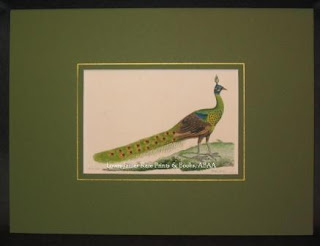In today's travel section of the New York Times there is a terrific article on
Birding in India, illustrated with color glossy photographs of showy birds in their technicolor settings.
Today we have the opportunity and ability to span the globe
in search of the world's most splendid natural wonders, and many do.
These fortunate folk are known as Eco Tourists.
During the 18th and 19th Centuries, international travel wasn't as opportune.
Thus witness the birth of a new demographic: The Armchair or Parlor Naturalist, a person who in simplest terms was passionate about the discovery of new species, and who, without the means as a worldwide explorer, enjoyed the joy of discovery from the comfort of his or her study or parlor.
Thus accompanying the ranks of the armchair traveler, this new interest created opportunity for an entirely new interest audience, and the book publishing world took note.
The late18th and early 19th centuries witnessed the blossoming
of several fine naturalist's compendiums, illustrated with meticulously rendered and lavishly hand-colored engraved illustrations Two such works were The Naturalist's Miscellany written and illustrated by Dr George Shaw and Frederick Polydore Nodder in London between 1790 and 1813,
and The Naturalist's Library, written and edited by Sir William Jardine in Edinburgh, beginning in 1836.
In the pages of these fine volumes, the glories of natural world were available for everyone's enjoyment.
Both The Naturalist's Library and The Naturalist's Miscellany excelled at the discovery, documentation and representation, from both life and perfected stuffed specimen, of new species: birds, animals, insects and aquatic life, from often previously uncharted territories around the globe.
 | |||||||||||||||||
| Tussah Silkworm |

Wonderful new images now filled the minds, hearts and souls of the previously uninformed.
And due to their discovery and documentation, many species were exported worldwide
to survive in lands far from their natural habitats.
All images courtesy of Lowry-James Rare Prints & Books, ABAA






No comments:
Post a Comment